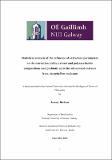Statistical analysis of the influence of extraction parameters on the extraction yields, extract and polysaccharide compositions and prebiotic activities of seaweed extracts from Ascophyllum nodosum

View/
Date
2013-02-18Author
Brebion, Jeremy
Metadata
Show full item recordUsage
This item's downloads: 3915 (view details)
Abstract
Brown seaweeds are found in abundance along the Irish coastline and investigations of purification of specific compounds including polysaccharides are still increasing to develop new markets. A preliminary investigation of the differences obtained on the polysaccharide extraction from three brown species (Fucus vesiculosus, Laminaria digitata and Ascophyllum nodosum) had been initiated and the algae A. nodosum had been identified as the most suitable biomass for an industrial point of view. A full factorial experimental design was performed to define the influence of extraction parameters (time, temperature and the volume of extractant per gram of biomass: liquid/biomass ratio) on the main water soluble compounds extractable from industrially processed A. nodosum. Additionally, seasonality was also investigated by applying the experimental design on two seaweed batches harvested at different time points of the year. This statistical approach aimed to figure out the yields and the composition variations of one step aqueous extracts, to optimise the protocol to extract specific compounds (polysaccharides, phenolics¿) and mathematical models were proposed to anticipate the extracted products. Moreover, extraction protocols had been shown to statistically affect the composition and size of the polysaccharide extracted (fucoidans, laminarans and alginates). Finally, the different extracts prepared were tested for their potential prebiotic activity. A preliminary screening of the ability of potentially pathogenic bacterial strains and probiotic strains to grow on seaweed extracts was achieved. Results on bioactivity were then correlated to the protocol used and, by extension to the extract composition (relative proportion of each component of the extract and composition of the polysaccharides). The possibility of scaling up the extraction was investigated in order to anticipate the production of the most promising extract to run a human clinical trial.
Collections
Except where otherwise noted, this item's license is described as Attribution-NonCommercial-NoDerivs 3.0 Ireland
Related items
Showing items related by title, author, creator and subject.
-
Acetic acid and pepsin result in high yield, high purity and low macrophage response collagen for biomedical applications
Delgado, Luis M; Shologu, Naledi; Fuller, Kieran; Zeugolis, Dimitrios I. (IOP Publishing, 2017-08-02)Collagen based devices are frequently associated with foreign body response. Although several pre(e.g. species, state of animal, tissue) and post-(e.g. cross-linking, scaffold architecture) extraction method factors have ... -
Intent classification by the use of automatically generated knowledge graphs
Arcan, Mihael; Manjunath, Sampritha; Robin, Cécile; Verma, Ghanshyam; Pillai, Devishree; Sarkar, Simon; Dutta, Sourav; Assem, Haytham; McCrae, John P.; Buitelaar, Paul (MDPI, 2023-05-12)Intent classification is an essential task for goal-oriented dialogue systems for automatically identifying customers¿ goals. Although intent classification performs well in general settings, domain-specific user goals can ... -
The influence of collagen isolation, cross-linking and sterilisation on macrophage response
Delgado, Luis Maria (2018-03-07)Collagen-based devices are frequently associated with foreign body response. Although several pre- (e.g. species, state of animal, tissue, isolation protocol) and post- (e.g. cross-linking, scaffold architecture, sterilisation) ...

